Contents
As a common source of power, air compressors are widely used in various industries. Most manufacturing facilities need an air compressor system for their production line. But it’s not easy to make a decision among many kinds and different brands of air compressors.
How to choose the right air compressor for your industry? Beneair Compressor will provide a detailed guide for your reference.
First of all, some questions to ask yourself before buying the air compressor:
What Compressor Size do I Need?
What Compressor Size do I Need?
An appropriate selection is beneficial to both the end-user and the compressor equipment: A too-large selection is too wasteful and may lead to mechanical problems; A too-small selection may lead to a long-term loading state, and insufficient airflow or pressure.
So the pressure and airflow requirements for your facility are essential when choosing an air compressor.
What amount of pressure(PSI) do I need?
What amount of pressure(PSI) do I need?
We use PSI (pounds per square inch) or Bar (metric measure of pressure) to measure the pressure. We can understand the air pressure as to how strong the force or power. For example, 3~4bar compressed air can blow Glass bottles, but can’t blow PET bottles, as it needs 30~40bar compressed air to blow.
To determine how much pressure is required? The first thing is to calculate what is the maximum operating pressure needed for your facility? Then plus about 1~2bar. The 1~2bar is for pressure loss:
- The distance from the installation site to the actual gas-side
- The size of the pipe diameter
- The number of turning points
So, we can install the air compressor to the air end as near as possible. If the distance between the air compressor and the air end pipe is too far, the path of the main pipe should be enlarged.
What is the right airflow(CFM) for my compressor?
What is the right airflow(CFM) for my compressor?
We use CFM (cubic feet per minute), L/min(liters per second), m3/min(cubic meters per minute), or m3/hr(cubic meters per hour) to measure the airflow.
To determine how much airflow is required? First of all, check the CFM requirements of all the air tools that will be used at the same time. Then plus about 20%~30% for unknown or increased needs.
- For a new project, it can be chosen based on the flow value provided by the design institute.
- For a renovation project, we can reference the original parameter values, in combination with actual air usage.
- To supply compressed air to your main equipment, learn the air compressor parameters from your supplier.
What horsepower (HP) is needed for my air compressor?
What horsepower (HP) is needed for my air compressor?
The steps for selecting an air compressor are:
- First, determine the working pressure,
- Then, the corresponding volume flow,
- Finally, the motor power.
With constant power, when the rotation speed changes, the flow and pressure also change. For example, a 22KW air compressor: when the pressure is determined to be 7 bar, the airflow is 3.7 m3 / min; when the pressure is determined to be 8 bar, the airflow is 3.4 m3 / min. The speed must be reduced when the air pressure is increased, otherwise, the drive motor will be overloaded, so the airflow is also reduced accordingly.

What Air Compressor Features do I need?
What Air Compressor Features do I need?
What type of air compressor do I need?
What type of air compressor do I need?
According to the working principle, the air compressor can be separated into two types: Positive displacement and dynamic.
Positive displacement type includes the reciprocating air compressor and rotary air compressor (such as screw type and scroll type air compressor).
And the screw-type can be divided into a single-screw air compressor and a twin-screw air compressor.
Do I need an oil-free or lubricated compressor?
Do I need an oil-free or lubricated compressor?
First of all, we need to know the question below
What is the difference between an oil-free and oil-lubricated air compressor?
The difference is the oil content in compressed air. For the Class 0 oil-free air compressor, we use water as the lubricating medium instead of oil, so there will be no oil at all.
For the oil-lubricated air compressor, we use oil as the lubricating medium, so the compressed air will contain oil. But which can be reduced down to 0.003 microns by filters.
Then, Should I go with a Class 0 oil-free air compressor or the oil-lubricated air compressor?
What you need to do is to assess your facility’s requirements.
- If your plant can’t tolerate any oil in contact with the product, choosing a Class 0 oil-free air compressor is a must. Such as pharmaceutical, food & beverage, hospital, critical electronics, and other industries. To ensure that there is no chance of contamination by oil.
- But, if there is no need for 100% oil-free, the majority of manufacturing, industrial or small workshops use Oil-lubricated compressors. Although there is oil in compressed air, they use filters to reduce the oil content. Because it will be more economical.
What Cooling method should I choose?
What Cooling method should I choose?
There is no doubt that a water-cooled air compressor has better cooling efficiency, but for most small models, it is better to use the air cooling type air compressor.
There are four shortcomings of Water cooling type air compressors:
- It needs a water supply and discharge system, which requires a large investment;
- The life of water-cooling coolers is short;
- In the winter, it is easy to freeze;
- It needs a large amount of water during normal operation.
But for the large models or with a bad ventilate condition, it’s better to use the water cooling model to ensure high cooling efficiency.
Should I choose the VSD air compressor?
Should I choose the VSD air compressor?
The VSD(Variable Speed Drive) air compressor uses the variable frequency inverter compared with the regular Fixed speed air compressor.
the advantages as follows:
- Achieve constant pressure air, provide stable air source for users
- Stable start reduces the impact on the power grid, extends the mechanical life of the motor and the whole unit
- Adjust the airflow as the actual needs
- Energy-saving about 20%
If there is fluctuation in flow demand between shifts, choosing the VSD air compressor will be a good option and offer great savings.
Single Stage or Two-Stage Compressors?
Single Stage or Two-Stage Compressors?
Our two-stage screw type air compressor can provide pressure up to 40bar(580psi). The first stage can provide 7~8bar and the second stage can compress to 30~40bar, which is widely used in the PET bottle blowing industry.
If your psi requirements are below 145psi, t a single-stage system will be enough. But a Two-stage screw air compressor may provide a more efficient operation.
Generally, compared with a single-stage screw air compressor, we use two-stage technology to save energy. Two-stage compressor(or Dual-stage compressor) energy-saving 5%~13% over equivalent sized single-stage compressors. But why?
- Adopt two-stage compression to attain reasonable pressure distribution and reduce each compression ratio, which can achieve the compressor’s power savings. In a single-stage compressor operating at 100 PSIG at sea level, the compression ratio is 7.9 to 1 (in absolute terms). But a two-stage compressor operating at the same pressure will have a compression ratio of 2.8 to 1 in each stage (2.8 is the square root of 7.9).
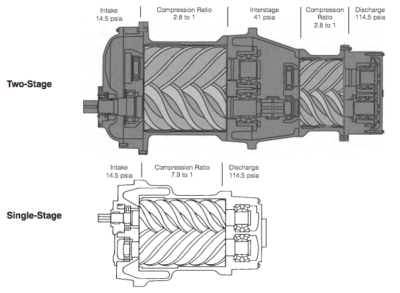
- The low compression ratio reduces the internal leakage and improves volumetric efficiency.
- The low compression ratio reduces the bearing load, improves the bearing life, and extends the life of the host.
What kind of motor should I choose?
What kind of motor should I choose?
Compared with the asynchronous motor, the permanent magnet synchronous motors (PM motors) are more efficient, and has a wide high-efficiency range:
- For the permanent magnet synchronous motor, when the speed range is 25% -99% of the rated speed, the efficiency can reach 95% -97%.
- But for the Asynchronous motor, only when the speed range is 70% -99% of the rated speed, the efficiency is about 88%. And what’s more, when the speed range is lower than 70% of the rated speed, the efficiency will drop sharply.
Belt drive or direct drive?
Belt drive or direct drive?
Belt-drive means there is a belt that connects the motor to the air compressor. The motor running speed is relatively slow and stable, and the speed is increased by the belt-shaft ratio. But the advantage is the low cost of replacing the belt and it is easier to install and maintain.
Direct drive means the motor directly connected to the crankshaft of the air compressor. It has high speed, stable operation, and high efficiency, but the replacement cost is higher if it is damaged. In terms of a 6m3/min model, the power is 37kw, we should pay more attention to the efficiency, so the recommendation is to buy the direct drive type. For small models, the difference is not much.
Portable or stationary air compressor?
Portable or stationary air compressor?
The crucial factor for you to choose is the location of your air compressor: indoor or outdoor.
A stationary air compressor is generally driven by an electric motor. With a larger volume and power, generally used in the stable supply of air. They can run with standard voltage in your home or factory. So the condition is that you have steady access to an electrical outlet and there is no need to move it frequently.
A Portable or a mobile air compressor mostly uses a diesel generator for power. The power is not very large and it is easy to move, such as mining, outdoor construction, and so on.
For some small models, the electric engine air compressor can also be designed as portable, with wheels. you’ll have more options in deciding where to put it and when to move it.
What kind of engine do I need? Electric or Diesel engine?
What kind of engine do I need? Electric or Diesel engine?
- In terms of the application, as long as there is electricity in the workplace, it is better to choose the electric engine. Because diesel-driven air compressors are powered by diesel engines, the efficiency is definitely not as high as motors.
- In terms of gas consumption, for the same pressure and airflow, the price of diesel engines is at least 1.5 times that of electric mobiles. because it needs the extra engine.
- In terms of stability, the air compressor part is similar, but the diesel engine increases the possibility of failure. So the electric type is more stable.
- In terms of maintenance costs, diesel engines increase the maintenance of diesel engines. So the maintenance cost of electric type is lower.
Of course, if there is no electricity in your workplace, you have no choice but to use a diesel-engine air compressor.
Generally, diesel-driven air compressors are mostly used in outdoor engineering. For example, large-scale construction sites, stone fields, mining industry, and other occasions. Besides, for underground operations or some special occasions (such as flammable gas), an electric air compressor with explosion-proof measures must be used.
Single-Phase Vs Three-Phase Voltages
Single-Phase Vs Three-Phase Voltages
Before buying an electric air compressor, we need to know the place it will be used. The motor voltage should be matched to the power source in your workplace.
Single-phase power generally is used in your home, apartment buildings, and other businesses. But there is a limitation with single-phase power and compressors, the air compressor can be produced as high as 10 HP in single-phase power for most manufacturers.
For most industries, they use three-phase voltage to operate their equipment, which is more efficient but may cost more than traditional single-phase power.
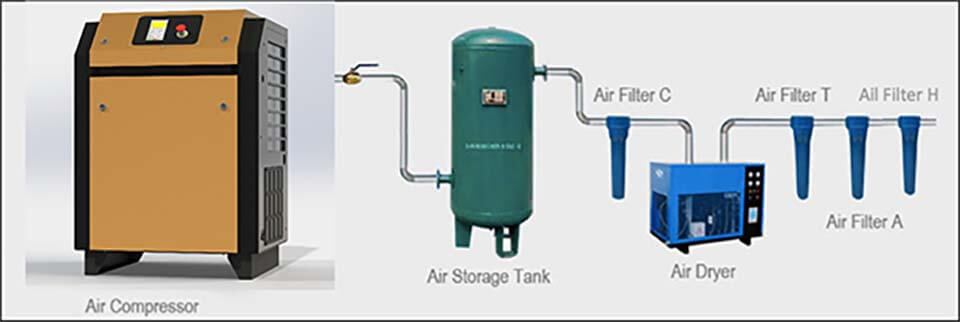
How to choose the after-treatment equipment?
How to choose the after-treatment equipment?
First of all, We need to confirm What is the compressed air quality I need. We need to know which contaminants can we find in compressed Air?
Compressed air contains substances such as water, oil, and dust. That may contaminate the final products and even increase costs.
So we should choose an oil-free or oil-lubricated type air compressor first, then use air treatment such as dryers and filters to produce the dry and clean compressed air to meet your needs.
Do I need very clean air?
Do I need very clean air?
As we talked before, if your facility can not tolerate any oil, the oil-free type air compressor should be chosen. For the oil-lubricated type air compressor, we can find oil and particles in the compressed air, but they can be reduced by filters:
- C grade air filter: Liquid Separator Filter (Oil content:5ppm, Particle:3μ)
- T grade air filter: Particulate Filter (Oil content:0.5ppm, Particle:1μ)
- A grade air filter: Oil Remover Filter (Oil content:0.01ppm , Particle:0.01μ)
- H grade air filter: Charcoal Filter (Oil content:0.003ppm , Particle:0.01μ)
- F grade air filter: High-Efficiency Oil Remover Filter (Oil content:0.001ppm, Particle:0.01μ)
Do I need very dry air?
Do I need very dry air?
All atmospheric air contains water. And when the air is compressed, the water concentration will increase. To avoid future problems in the compressed air system, the wet air needs to be treated by using drying equipment.
First of all, we need to know What pressure Dew Point is?
Dew point is a measure of the amount of water vapor in compressed air. In other words, the colder the dew point, the less water there is in the compressed air. Simply, it’s the temperature at which water vapor condenses into water.
Which kind of Air dryer should I use?
Air dryers can help lower dew point temperatures and keep liquid water out of air compression systems. Selecting the right dryer to treat wet compressed air is dependent on the requirements of the machines that use compressed air.
Most industrial and manufacturing facilities can achieve such requirements with a refrigeration air dryer. While some pharmaceuticals plant, medical operations, laboratory users need an adsorption dryer to supply critically dry air.
For the costs, the lower the dew point required, the higher the investment and operating costs for air drying.
- Refrigeration air dryer (Dew point: 2~10℃)
- Heat Regeneration Adsorption Air Dryer (Dew point: <-25℃ or -40℃)
What size of the air receiver tank do I need?
What size of the air receiver tank do I need?
An air receiver tank is to store compressed air, and can maintain a steady and constant supply to your production process.
- Store compressed air, on the one hand, can solve the problem that air consumption is greater than the air supply in the system in a short time. On the other hand, it can be used for an emergency stop when the air compressor fails or other emergencies (such as power supply).
- Buffer pressure, because the pressure of the discharged air has fluctuations, by using an air storage tank, the compressed air pressure for the air end can be more stable.
- Pre-dewatering. The water vapor in the air after compressing becomes liquid water droplets. Most of these water droplets will be deposited at the bottom of the air storage tank. There is a drain valve at the bottom of the gas storage tank. It can be discharged manually or automatically.
The volume of the air storage tank should be between 10%-20% of the airflow of the air compressor. We generally choose 15%. When the airflow is large, the volume should be increased. If the air consumption on site is small, it can be less than 15%, but not less than 10%.
What’s the cost of the air compressor system?
What’s the cost of the air compressor system?
- For the initial purchase costs, the scroll, screw, and centrifugal type are more expensive than the reciprocating type air compressor. And the oil-free type will cost more.
Most people think that the initial purchasing costs the majority of the total cost of compressed air. But it is wrong. In fact, the purchase costs represents only 10%~20% of the total costs to own and operate the compressor in the first five years. The electricity to operate costs about 70% and the maintenance costs about 10%~20%. That’s why more and more people would like to buy a more energy-saving air compressor.
For example, if you look at the total cost, why a water-lubricated oil-free screw air compressor is well worth the investment. It reduces expenditures in these ways:
- Cutting maintenance costs and treating oily condensate costs: Avoiding expensive oil, oil filter, air-oil separator, oil cooler costs. Low temperature reduces stress on components ensuring long life.
- Avoiding energy lost due to hot air discharge: The superior cooling capability of lubricating water removes the heat and gives more air per kW of power.
- Avoiding the costs of extra energy to combat pressure drops due to filtering.
These costs, although not apparent at the time of purchase, are very high and contribute substantially to the total cost of ownership.
Now you can choose the air compressor from our Product Page or Contact us to get a proposal that tits the problem now and in the future.

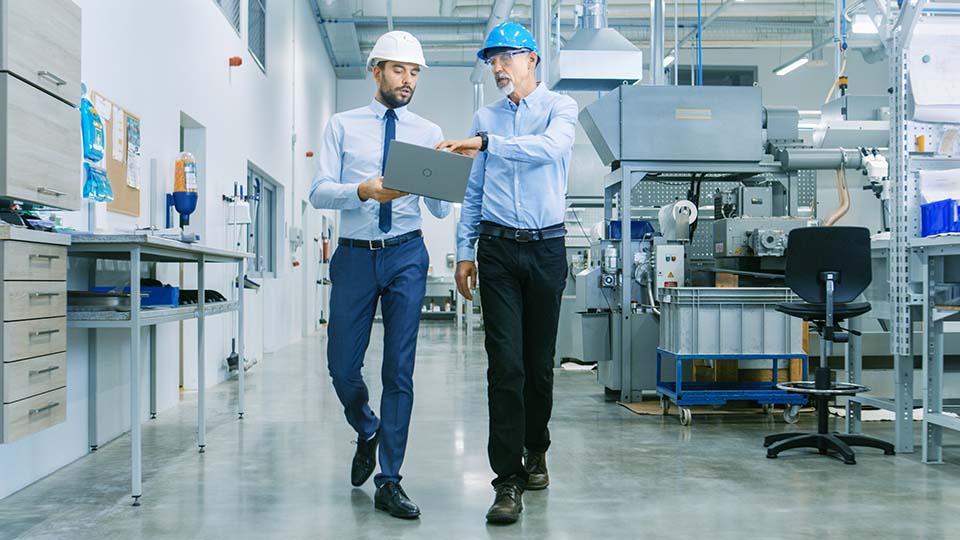
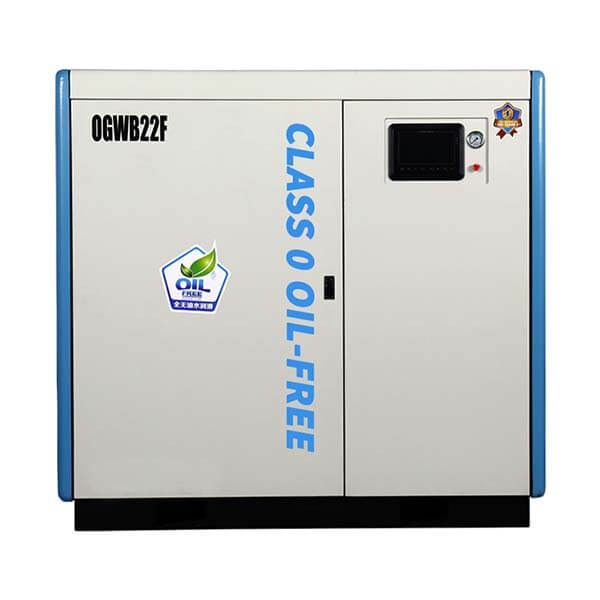
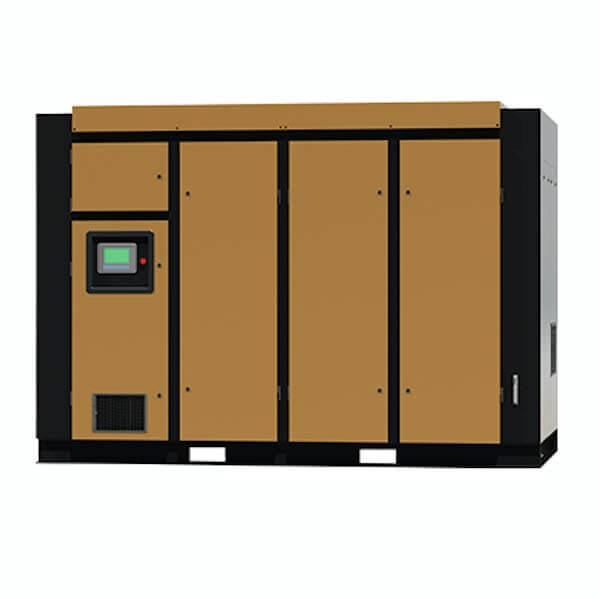

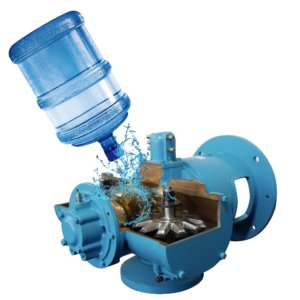
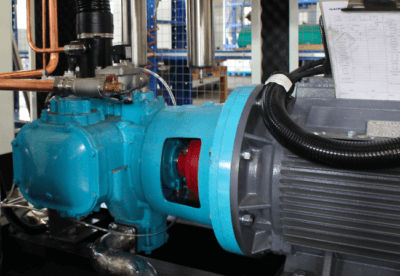
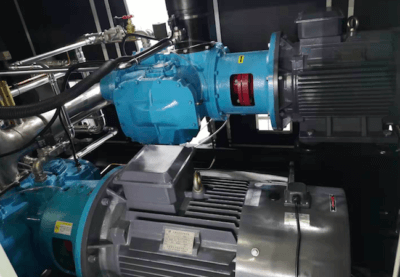
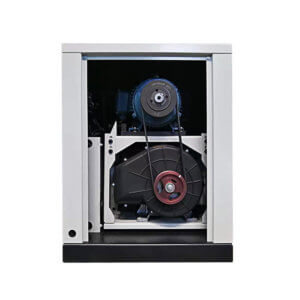
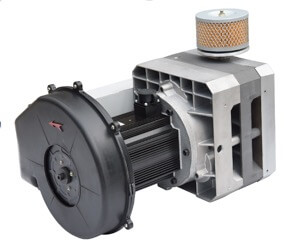
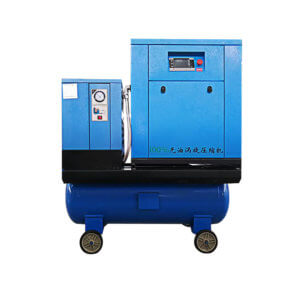
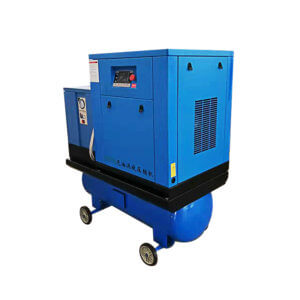
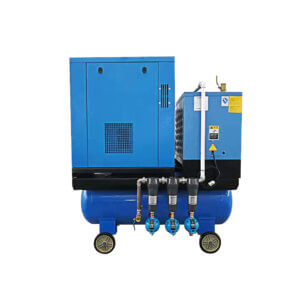
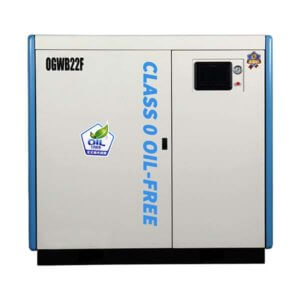
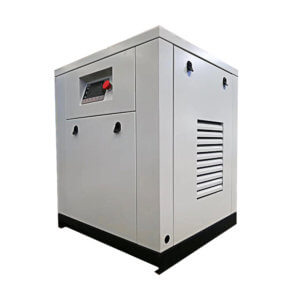
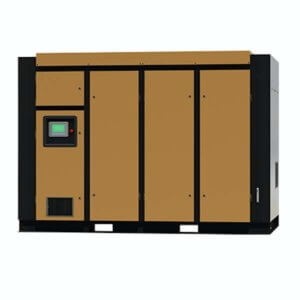
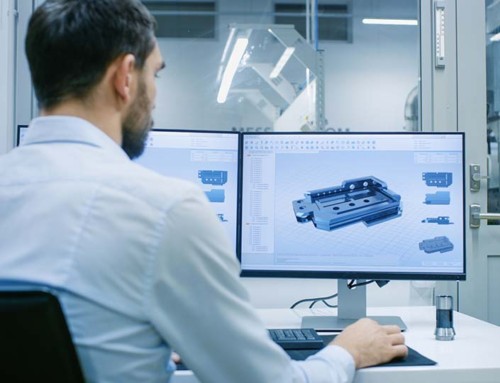
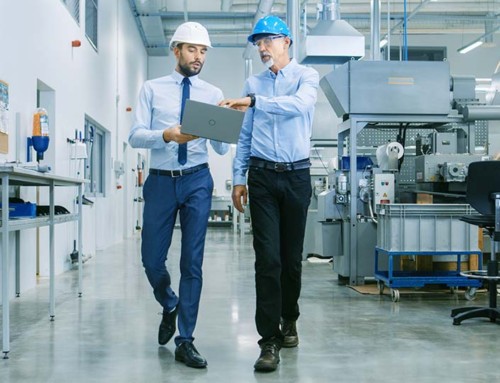
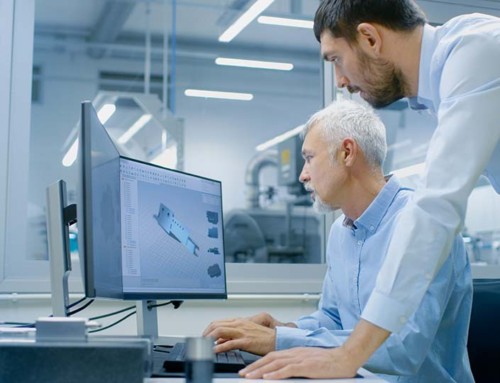
Leave A Comment